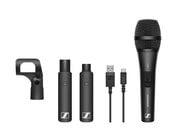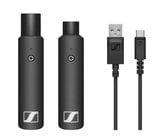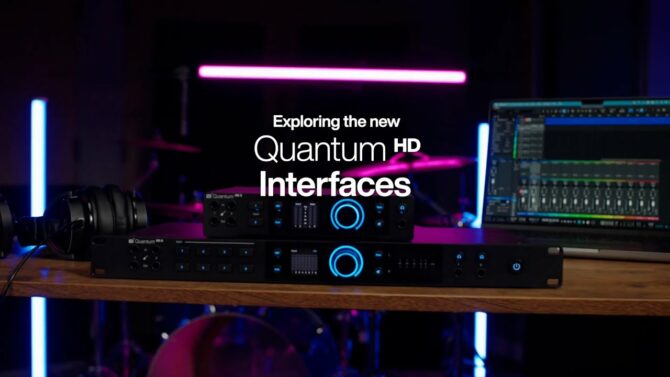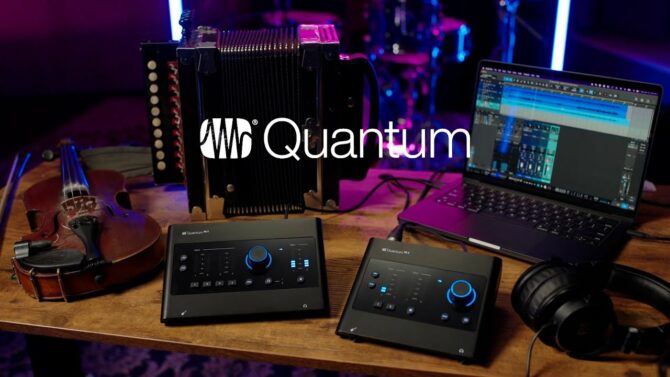The wireless for the rest of us…
Sometimes it seems the only part of pro audio that hasn’t been transformed by digital Definition:
Definition:
A signal or data expressed as series of the digits 0 and 1, typically represented by values of a physical quantity such as voltage or magnetic polarization. technology is mic stands and gaffer’s tape—but one of the most radical transformations involves wireless technology for audio.
I used an analog Definition:
Definition:
A signal that is continuous in nature, as opposed to being defined as a series of discrete numbers (or elements) as found in digital signals; electrically "analogous" to an acoustical signal in the air. wireless mic and wireless guitar system once. That was all I needed to know that wireless would never be in my future. Between the horrible audio quality due to companding Definition:
Definition:
The process of increasing dynamic range and lowering the noise of a recording or transmission system. See Compansion. (the only way to squeeze audio into the limited bandwidth Definition:
Definition:
A range of frequencies that a device can generate, reproduce, or process. This usually implies little or no alteration within the range.), and the system going insane if I skirted the available range, I was more than happy to go back to cables.
That is, until digital wireless came along. Once burned, twice shy, and I was reluctant to even give digital a try. But the first thing I noticed was that it sounded good. Not just “okay,” but good. And then when I wanted to see what happened once the system was out of range...well, nothing happened. It just went from carrying audio to silence. And the system stayed silent until I was back in range.
That was a great start. But digital wireless systems remained somewhat expensive, ate batteries for breakfast, and were fiddly to adjust. So I had hope for the future—you know how digital technology likes to get better and more affordable—but kept watching and waiting.
Well, Sennheiser knows a thing or two about wireless, and a thing or two about microphones. So when I had the opportunity to review the XS Wireless Digital system (XSW-D for short), I jumped at the chance to find out how a modern digital wireless system performs.
The XSW-D Family
We’re not dealing with a single product, but a family of products where the individual members have a lot in common. I tested three pairs of transmitter/receiver combo: instrument, with 1/4” plugs; mic, with XLR connectors (female for the mic, male for the receiver); and 1/8” minijack (primarily for lavaliers—see Fig. 1). Sennheiser also sent the other family elements like a matching mic, lavalier, charging cables, and an assortment of clips and mounts so I could test them all easily. Note that you don’t have to buy all of these. There are various bundles so if you’re just a vocalist, you get what’s needed for a mic...if you play guitar, then you get the instrument version. If you sing and play guitar, you get both.
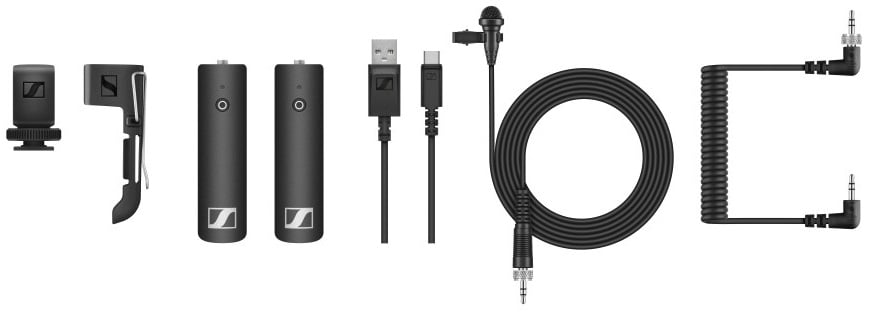
All the transmitters and receivers are small, light, and use rechargeable batteries. All units charge via USB-C, and Sennheiser includes a USB-A to USB-C charging cable. Note that these units are pretty much immune from current USB-C charging controversies (“I can’t charge my laptop from USB-C! What’s up?”) because they draw so little current.
Aside from the models with XLR connectors, the transmitters and receivers are about 3.5” long, 1” high, and 1” wide (tapering down to about 5/8” wide), and weigh under two ounces. The transmitters and receivers with XLRs add about 0.5” to the length, and 0.5 ounces to the weight. Seriously (yes, I double-checked). In fact, aside from the XLR-based version, it’s hard to tell the receiver and transmitter Definition:
Definition:
Any device that sends an electrical signal, typically radio waves or by wire. apart unless you look at the bottom label. Sennheiser thoughtfully provides small, color-coded labels in six colors to make it easy to see what’s what under low ambient Definition:
Definition:
1. Something in a close vicinity. 2. The natural sound of a space, or simulation of being in that space. lighting conditions.
Speaking of the bottom label, there are graphics that identify what each device does. On the instrument version, the one with the guitar graphic plugs into your guitar, and the one with the amp Definition:
Definition:
Abbreviation for either Ampere or Amplifier. graphic—wait for it—plugs into your amp. There also icons for mixer Definition:
Definition:
Combiner, controller, and router for multiple audio or video signals., camera, and mic. It’s hard to mess up. When plugging into a camera input, you can’t mount the receiver on the camera itself (after all, there’s no standard), but the coil Definition:
Definition:
(slang) Inductor; its derivation is that most inductors are made up of coils of wire. cord stretches sufficiently to reach a receiver attached to the camera tripod or mount.
The Bundles
We’ll talk about performance and specs in a bit, but let’s look at some of the available bundles, because one of the most important aspects of this system is that not buying à la carte can save you quite a bit of money.
Vocal Set: cardioid Definition:
Definition:
A microphone's heart-shaped directional pickup pattern. dynamic mic, XLR transmitter and receiver, and mic clip.
XLR Base Set: the same, but without the mic (Fig. 2).
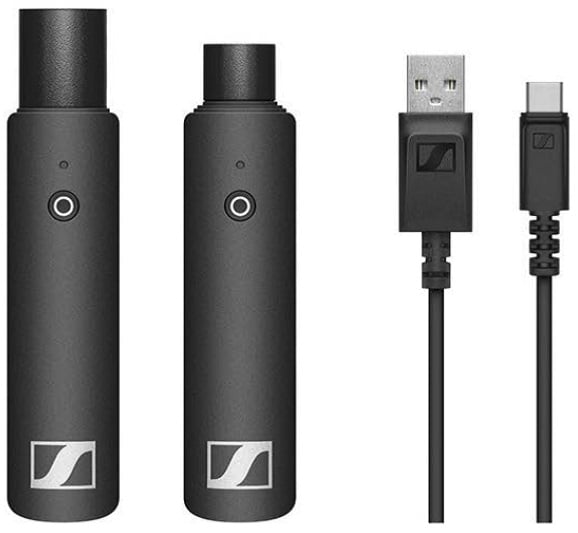
Lavalier Set: ME2-II clip-on lavalier mic, 1/8" transmitter, XLR receiver, belt clip
Portable Lavalier Set: Same as above, but with 1/8" receiver, cold shoe Definition:
Definition:
The same physically as a hot shoe used for mounting flash guns on a camera, but provides no power or control. mount, and 1/8" coiled cable. Portable sets are oriented toward videographers.
Portable Interview Set: Same as the Lavalier set, but with XLR transmitter instead of 1/8" transmitter
Presentation Set: Same as the Lavalier Set, but without the lavalier mic
Portable Set: Same as the Lavalier Set, but without the lavalier mic, and with the 1/8” coiled cable
Portable Eng Set: Same as the portable lavalier set, but also includes a 1/8” transmitter
Instrument Set: Guitarists, take note—1/4" transmitter and receiver, belt clip, and 1/4” extension to go from your beloved guitar to the transmitter
Pedalboard Set: The good news is that it’s clear someone at Sennheiser plays guitar. This includes the 1/4" pedalboard receiver with tuner, 1/4" pedalboard transmitter, 1/4" extension cable for guitar to transmitter, and 1/4" patch cable to send the pedalboard receiver to your pedalboard. I didn’t get the receiver/tuner to check out, but it’s cool Sennheiser had the presence of mind to think of this.
So Do They Work?
Here’s the deal. We all know that digital wireless works. The question is whether Sennheiser does something that pushes the envelope with respect to how easy is it to get it to work, how long do the batteries last, and what’s the range. So it’s testing time.
The XS series operates at 2.4 GHz Definition:
Definition:
Abbreviation for Gigahertz, which equals 1,000,000,000 cycles per second.. This means it’s not operating out of the FCC’s guidelines and is compliant not only with current FCC Definition:
Definition:
FCC (Federal Communications Commission): U.S. Government agency that regulates communications standards and licensing. regulations, but will be for the foreseeable future. The only disadvantage of 2.4 GHz operation is potential interference with other 2.4 GHz devices, but in the worship/performance/presentation environment for which the XS series is intended, this shouldn’t be much of an issue.
The quick start manual is designed for the post-literate age. Or to be more charitable...Sennheiser is an international company, and not everyone speaks English. I went online to look at the full manual, but really, the system isn’t very complicated. You do need to understand what the LED Definition:
Definition:
LED (Light-Emitting Diode): A semiconductor light generator used in displays, television, pointers and for general illumination. It is a low-power replacement for incandescent lamps. colors mean (lit solid, lit blinking, red, green, etc.), but once you figure that out, the concept is logical enough you probably won’t forget what you need to know.
Ease of use...well, you press and hold the buttons on the transmitter and receiver simultaneously. They pair. Done. If you need more info, look at the LEDs: you can tell whether power is on, whether the battery Definition:
Definition:
An assembly of series-wired cells that provides higher voltages than individual cells. is charging, whether the units are waiting to be paired, or in fact paired.
Sennheiser has automated as much of this as possible; the system selects what it finds is the best frequency Definition:
Definition:
A value, expressed in Hertz, that indicates how many cycles of a periodic signal occur in one second. , so you don’t have to fiddle with it. Some might see this as a disadvantage if they expect deep control over the system. But the XS system makes the right decisions. Who am I to argue?
The Batteries
The review units were sent with the batteries pretty much depleted, and the system won’t work under those circumstances. Charge the devices fully before attempting to use them (a first-time full charge is also good practice for extending battery life).
Thankfully, Sennheiser has not followed the unwelcome trend of saying after several years “oh, the battery doesn’t hold a charge anymore? Then throw the unit away, and buy another one.” Although you can’t replace the battery yourself, Sennheiser’s service centers will. However, this brings up a consideration: If you forget to charge the battery, you can’t just pop it out and replace it with another one—you have to wait while the unit charges. (It took about two and a half hours to charge a fully depleted battery to 100%, so take that into account.) Those using the XSW-D system in mission-critical applications will either need to be diligent about charging units after use (battery life is quoted as up to five hours, and my tests confirm that), or buying a spare receiver and transmitter, and making sure they’re charged. Redundancy is never a bad thing for real-time use, anyway.
But also note that using rechargeables means that over time, you should be able to save a considerable amount on battery costs. I do recommend a second charger and cable so you can charge two devices at once; if you have a phone with a USB-C jack Definition:
Definition:
A connector, normally female, that works in conjunction wit a plug. Usually located in a piece of equipment, or as part of a cable., you can use its charger and cable.
Performance
Range is quoted at 250 feet with line-of-sight operation. I found you can actually go a little further under the right conditions, but I wouldn’t count on exceeding the spec. Of course, anything that interferes with the signal, like walls or even people, will diminish the range. So, I tried a distance of about 75 feet, from first floor to second floor, with multiple walls, ceiling, and a floor in between, along with various objects getting in the way as well. Operation was perfect. Overall, it’s hard to imagine a stage situation where the range wouldn’t be enough…and I must admit I was taken aback that the signal could cope with so many impediments in between the receiver and transmitter.
Regarding electric guitar (Fig. 3), although I couldn’t measure the input impedance Definition:
Definition:
The load an input circuit places on the source; loading can reduce levels or alter frequency response. In modern audio gear, the input impedance is about 10 times higher than the source impedance, called bridging. In traditional, radio frequency, video and long-distance telephone circuits the source and destination impedance are matched (600 ohms in audio, 50 or 75 ohms for RF and video)., there was no frequency response Definition:
Definition:
The range of frequencies that an audio, video or data device can pass. difference when using a cable (nor was any difference detectable with a spectrum analyzer).
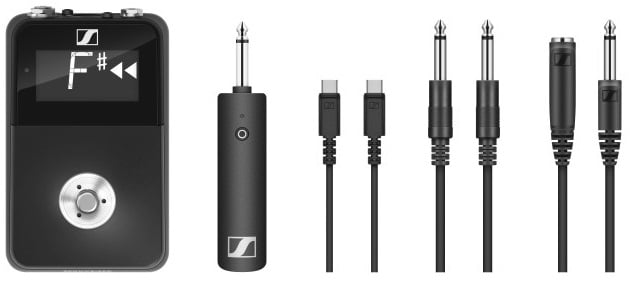
And true to digital form, if you go out of range, the sound just stops; there are no wild sci-fi effects, like what can happen when analog systems operate on the edge. We’re dealing with the digital age here: the system is either “1” (you hear the audio) or “0” (you hear silence).
Summing Up
There’s much to recommend the XS wireless digital line—starting with no bulky receiver! Having unobtrusive, lightweight units for transmitter and receiver almost makes it seem like they’re not there. Some might object to the minimal one button/one LED UI, but I don’t. Use the system a couple of times, and it’s second nature.
The rechargeable batteries are great, as long as you remember to keep them charged. The fact that Sennheiser service can replace them if they lose their ability to be charged a few years down the road is commendable.
2.4 GHz is a world-wide standard that’s not going to go away, the range is generous, and operation is pretty much non-critical. However, I would be concerned about an environment where there’s a lot (and there would have to be a lot) of 2.4 GHz electromagnetic interference. To be fair, though, EMI Definition:
Definition:
(ElectroMagnetic Interference): Byproducts of electronic devices that generate magnetic fields, and which can disrupt audio, digital, or RF communications or signals. See also: Faraday Cage. is the traditional nemesis of all things wireless. Overcoming it requires far more expensive, complex, and elaborate systems.
Overall, to borrow a phrase from circa-1984 Apple, Sennheiser has come up with “wireless for the rest of us”—whether you consider it from the perspective of price point, ease of use, or overall efficacy. The cost is reasonable, but even more so when you buy a bundle. And speaking of bundles, it’s helpful that Sennheiser thought of instrumental, vocal, video, and broadcast applications.
I can see a lot of these being purchased by first-time wireless users who had hesitated to take the plunge. And in a world of competitive systems for electric guitar and bass, instrumentalists who need to go wireless will likely be swayed by Sennheiser’s reputation, the unobtrusive nature of the units themselves, and the performance.
I also believe there’s a ready-and-waiting market for video professionals (interviewers, news gatherers, on-air remote talent) for whom time is money. I have a fair amount of experience in that area, and I’ve noticed that the less time it takes to set up, the more it puts the person being interviewed at ease. Conversely, you don’t want them fidgeting around while you fiddle with cables and tweak Definition:
Definition:
1. To make minor adjustments. 2. A person who is a perfectionist. a receiver. To be able to push a couple buttons to pair the mic’s transmitter with the DLSR’s receiver, and say “okay, we’re ready” in only a few seconds, is reason enough for videographers to embrace this system.
Sennheiser did their homework: they’ve targeted specific market segments, and delivered what those segments need. I suspect that in the future, we’ll be seeing a lot of these on stages, in Houses of Worship, and on TV. Then again, maybe we won’t see them...they’re pretty small.




